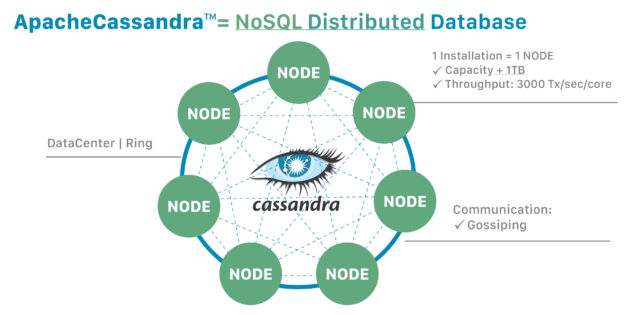Introduction
In the realm of modern data management, traditional relational databases often fall short when it comes to handling the demands of today’s massive and ever-evolving data landscape.
Enter Cassandra, a distributed NoSQL database that has risen to prominence due to its ability to handle vast amounts of data while maintaining high availability and fault tolerance.
In this blog post, we’ll take a comprehensive look at Cassandra, exploring its architecture, key features, use cases, and benefits.
Understanding Cassandra’s Architecture
Cassandra, developed by Facebook and later open-sourced, is designed to manage large volumes of data across multiple commodity servers while providing a high degree of scalability, reliability, and performance. It’s categorized as a wide-column store database, enabling it to efficiently manage unstructured, semi-structured, and structured data.
The architecture of Cassandra is based on a peer-to-peer model, where every node in the cluster plays an equal role, eliminating single points of failure and bottlenecks. This allows Cassandra to offer high availability and fault tolerance even in the face of node failures.
Cassandra is often associated with the CAP theorem, which is a principle in distributed systems that states that it’s impossible for a distributed database system to simultaneously provide all three of the following guarantees: Consistency, Availability, and Partition Tolerance.
Instead, distributed databases must make trade-offs between these three guarantees.
In Cassandra trade off takes place for consistency.
Cassandra doesn’t need to perform join operations because of its distributed characteristics.
It uses query first approach rather than relational model approach
We design our tables for a specific query so that Cassandra can query only one table when user wants to get data.
Ring and Token Ring Architecture:

1.Node:
A node is a single server or machine in the Cassandra cluster. It stores data, participates in data replication, and handles read and write operations. Nodes communicate with each other to maintain consistency and distribute data across the cluster.
2.Data Centre:
A datacenter is a logical grouping of nodes within Cassandra. It represents a physical location or a separate infrastructure deployment.
Cassandra allows the configuration of multiple datacenters, enabling data replication across geographically distributed locations for fault tolerance and low-latency access.
3.Ring and token:
In Cassandra, nodes are arranged in a ring-like structure called the token ring. Each node in the cluster is assigned a range of tokens that determines its position in the ring. This token assignment helps evenly distribute the data across the cluster and enables efficient data routing.
4.Replication:
Cassandra replicates data across multiple nodes for fault tolerance and high availability.
5.Partitioning and Sharding:
Cassandra uses partitioning or sharding to distribute data across nodes. Data is partitioned based on a partition key, which determines the node responsible for storing that data. Each node is responsible for a subset of the data, allowing Cassandra to scale horizontally by adding more nodes.
6.Gossip Protocol:
Cassandra uses the gossip protocol for maintaining cluster membership and exchanging cluster state information among nodes. The gossip protocol enables efficient communication and discovery of new nodes, as well as detecting node failures or changes in the cluster.
7.Read and Write Path:
Cassandra follows a distributed read and write path.
When reading data, Cassandra can fetch data from any replica based on the configured consistency level.
When writing data, the data is written to the appropriate replicas based on the partition key and consistency level.
Use Cases for Cassandra
Time-Series Data: Cassandra excels in handling time-series data, where events are timestamped and need to be stored and retrieved efficiently, making it popular in industries such as finance, IoT, and monitoring.
Online Applications: Cassandra’s low-latency read and write capabilities suit real-time online applications like e-commerce platforms, social media networks, and gaming.
Analytics and Reporting: Its ability to manage large datasets and support complex queries makes Cassandra suitable for analytics and reporting applications.
Content Management: Cassandra’s distributed nature and high throughput make it a great fit for content management systems dealing with user-generated content.
Benefits of Choosing Cassandra
1.Scalability on Demand: Cassandra’s linear scalability lets businesses expand their infrastructure as data requirements grow, without compromising performance.
2.High Performance: Its distributed architecture and optimized data storage mechanisms enable fast read and write operations, crucial for responsive applications.
3.Fault Tolerance: The replication strategy ensures data remains accessible, even in the event of node failures or network issues.
4.Flexibility: Cassandra’s schema flexibility accommodates changing data models and reduces the need for extensive upfront schema design.
5.Global Distribution: With support for multi-data center deployments, Cassandra is well-suited for applications requiring global distribution of data.
Conclusion
Cassandra stands as a testament to the capabilities of NoSQL databases in addressing the challenges posed by today’s data landscape. Its distributed architecture, scalability, fault tolerance, and flexibility make it a compelling choice for organizations seeking to harness the power of their data efficiently. As industries continue to generate massive amounts of data, solutions like Cassandra provide the foundation needed to build robust, responsive, and reliable applications that can thrive in the face of modern data challenges.
